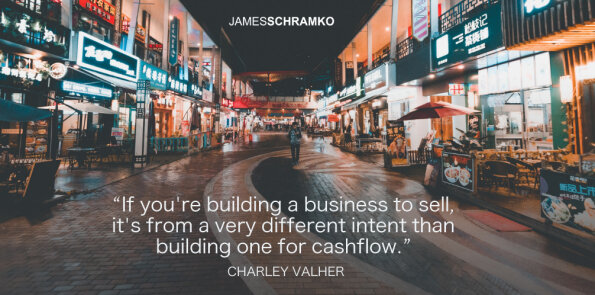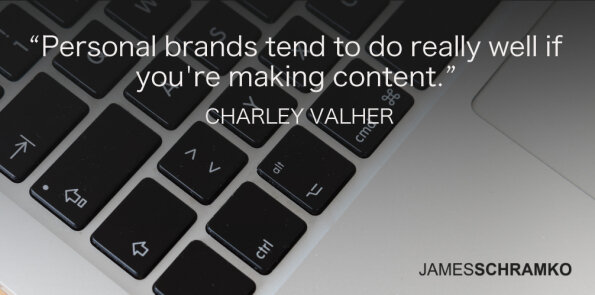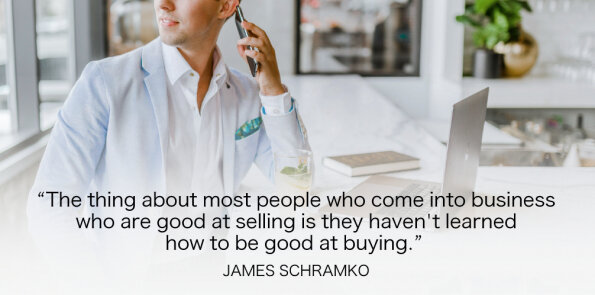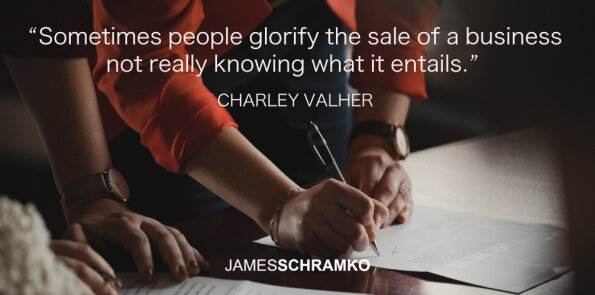Maybe you're building a business to sell one day. Or maybe you're just trying to make money now so you can live comfortably. There are pros and cons to both approaches, and it ultimately comes down to what your priorities are.
Entrepreneurs James Schramko and Charley Valher discuss the considerations, why one option might appeal more than the other, and why picking one is so important.
Podcast: Download (Duration: 35:34 — 36.3MB)
Get Notified Of Future Episodes Apple Podcasts | Spotify | Amazon Music | Android | Blubrry | Gaana | TuneIn | Deezer | Anghami | RSS | More
In this episode:
What is a full stack business owner, and why would you want to be one? [00:42]
Money to live on, or a future fortune? This is why the decision is so important…. [02:39]
James switched from company to personal brand, and has noticed several things. [05:32]
You can sell a personal brand business. Is the trouble worth it, though? [07:11]
There are ways you can actually do well with a personal brand… [10:15]
James used to be about building a business to sell. Here’s what’s changed since then. [13:23]
You can go with one or the other, but there’s really no right or wrong. [15:34]
Can you build with the intent to sell, and still have great business cashflow? [16:32]
People sometimes glorify the sale of a business, but it does come with difficulties… [17:48]
The process of selling a business profitably requires a certain set of skills. [22:26]
Are some business models more suited to selling than others? [26:18]
If you’re looking to sell your business, it’s a good idea from the start to have your number. [29:38]
Keep your head in the game of doing business, at least till you’ve made the sale. [31:00]
Determine and build your ideal business model with James’s help
Entrepreneurs generally build a business for one of two reasons – to live off the cashflow, or to sell it later down the line. And to examine those options, James has invited back fellow entrepreneur Charley Valher.
Charley is making great headway with one of his newest projects, the podcast Business & Investing, which works on the premise of building out the full stack of skills business owners need to excel.
Today’s topic is an idea he floated, and one James loves, as he encounters it a lot in his coaching.
Something all business owners should consider early
The ultimate purpose of a business is something James likes to know early as a business coach, because wanting to switch later has consequences.

Another distinction is, if you’re building a business to sell, you take into account its desirability for a potential buyer, something you wouldn’t consider if it were built for cashflow.
From the perspective of a business coach, the route an owner chooses would completely change the kind of advice James would give them. One of the most obvious considerations would be the naming of the thing. It’s rarely, for instance, that a business for sale would carry a personal brand.
What James noticed making the switch to personal
James recently made the switch from company brand to personal, and shares some of the learnings.
“For every decision you make, it’s going to change things down the track.” – James Schramko
For every decision you make, he says, it’s going to change things down the track. One, the switch for him was an admission that he couldn’t sell the business as it was. It would take time to reengineer it into something salable, which didn’t seem worth it. Better to spend that time and energy growing other people’s saleable businesses and get paid that way.
Then it made things simpler. They now had just one set of social accounts to manage. They had one prime product to focus on. Also, he says, you get a lot more traction faster under a personal brand, and you have a defensible position in the market, because there’s only one you.
The difficulties of selling a personal brand business
Charley has a story to share. He has a friend who sold a personal brand business, and it was a difficult process. First, he had a hard time getting a decent price. Would-be buyers would offer less because of the attachment to his brand.
Then the buyer golden-handcuffed him. Even once he’d sold the business, he had a 24-month term where he had to work in the business to help them de-risk it. And while it wound up successful overall, Charley’s friend said all the effort put into getting it salable was not really worth it.
James had his own realization with SuperFastBusiness. He’d always been building it with the idea of selling, but in reality was running it more like a cashflow business. And if one of the prime filters for selling was that it had to run without him, he realized it didn’t pass that, and that fixing it would take a while. He’d need to hire sub coaches and spend more on marketing that didn’t involve his personal podcast. And he didn’t want to do that.
On the flip side, there are personally branded businesses that run a lot like a business that would sell. They reinvest and reinvest in their branding, reducing their margins and delaying the cashflow event till when the business is a bigger size.
So it’s not a given if you choose to have a business to sell versus a business for cashflow that you’ll get the sale or that you’ll get the cashflow. These things still take work.
How to do well with a personal brand
Charley wholeheartedly agrees.

And while you may opt to go the cashflow route because of a personal brand, there are also a lot of great opportunities in that. You can use your brand to grow other businesses that you can sell. You can also take that cashflow you’re making in the business and invest it in other assets. You can buy investment products or other things from that, or even buy other businesses. There’s plenty you can do.
The one thing that concerns Charley is when someone has spent a long time building a personal brand and then suddenly wants to sell it, and they haven’t planned or thought out any other strategies for them to be well off along the way.
That’s huge, says James. One of the recurring themes he’s seen is that people have never even thought about whether they’re building to sell or for cashflow. So that’s one of the first questions in his diagnostic when taking on a student.
And on the topic of personal brands: if you’re going to have a cashflow business, and if you’re going to build a personal brand that’s likely very hard to sell, what James does personally – and this is not advice – is he takes money from his business and puts it into other asset classes and investments. His ultimate goal is to one day be able to turn off his business and live off the passive income. That’s his exit strategy.
There’s one or the other, but no right or wrong
Charley likens the two options to bodybuilding and marathon running. They’re both health-related, but very opposed, and it takes different elements to be successful in either.
You can focus intently on being a marathon runner, and do very well. Or you can optimize yourself for bodybuilding, and be a success there. But there is no right or wrong.
The mistake as a business owner is in not choosing, or trying to do both at the same time, with the same business, and expecting to be good at both. Charley thinks it would be very difficult, if not impossible, compared to focusing on just one or the other.
Can you build to sell AND have great cashflow?
James wonders, though, if you can build a business to sell that has great cashflow.
It’s clearly being done, says Charley. But businesses like that would have much better cashflow if it’s all they focused on. He speaks from experience, having sold his first business.
When it came time to sell, Charley found himself spending a lot of money on de-risking it, getting financial audits done, getting a team that could deliver what was needed, and myriad other things that went into preparing for a sale. A good cash flow business could be much stronger in cashflow without those expenses.
Some realities in the process of selling a business
Charley goes into a few more points, because sometimes people glorify the sale of a business, not really knowing what it entails.
Preparing to sell a business involves a lot of back and forth with the seller, meetings to address questions from either side. And rightly so, but it can eat up a lot of time.
And then there’s the anticipated pay day, where you get the full settlement and it’s done. Not how it works. There are handover periods – in Charley’s case it was a leveraged buyout where he received an amount each month over a duration of time till the total was paid.
What has been James’s experience?
One of the businesses he sold was smooth-sailing. It was the perfect business for the perfect buyer, who’d worked with James for a long time and trusted him. They agreed easily on the terms, and didn’t require a lot of legal intervention.
The other business he sold was larger, doing seven figures a year in revenue, and a bit more complex. James believes he could have sold it for more, had he reinvested some of the 50 percent profit margin into accelerating it. But it was a bit of an unintentional sale.
The main reason for selling, and a bit of a silly one, says James, is that one of his customers was buying so much of their product it had become a risk. And the only way to de-risk the business was to sell it to that customer, before he took it into his head to vertically integrate and take their business away.
The legalities became somewhat involved, but James’s lawyer spoke to the customer’s lawyer and they sorted it out.
He does agree, though, that in nearly all cases you won’t get all the money upfront, as they will try and mitigate some risk. That said, selling a business is something he’d like to experience again, for which end he’s building a business right now that will work without him.
The skills involved in selling a business
Did James feel like buying and selling a business required a different skill set? Charley did.

And in the car industry, you’re not selling a car unless you’re buying the current car off somebody, generally. If they’re trading in, you have to be a good buyer, as well as a good seller. And that’s a key experience James had.
James came to the online world with a lot of experience around buying and selling. And not just the technical process, not just the subtle nuances and experience around it, but the emotional and mental preparation involved. He can spend millions of dollars without flinching, because he’s worked with big numbers.
Also, in the lead-up to selling his business, he started interviewing people on his podcast about buying and selling businesses – John Warrillow, Thomas Smale from FE International. And he read books, like Built to Sell and Exit Rich.
All of this gave James a grasp of the basics. Essentially, you’ll have to show the potential to the buyer, you’ll need to prepare a book of sale, you have to only really show the offer to someone who’s qualified, you want to maximize the value in it by pointing out where all the opportunities are that they can develop.
And also, very important, you’ve spent years building this thing, but in a very short space, you’re going to capture the value for it. Your ability to do that could have a huge impact on the rest of your life. Because once that business is sold, there’s no more earning opportunity from that. So the difference between 50,000, or 100,000, or 500,000, or a million could be significant in the compound effect of how you’re going to invest that money down the track.
Are there business models more suited to selling?
Charley is curious: does James think there are certain types of businesses more suited to sell versus building for cash flow?
They’ve mentioned, for instance, personal brands, and established the higher likelihood of that succeeding more as a cash flow business.
E-commerce comes to mind for James. That’s easy to sell, as are content sites branded around a theme and not a person. Agencies are harder, especially if the expertise is tied to the owner operator. They’ll generally get a much lower multiple.
Two multiple for agencies, says Charley. Tiny. You’re almost better keeping it.
For a consultant, say a one-man band with an assistant, it’s almost one, says James.
Content is in. If you’re good with SEO, and images, and videos, it’s great. And you can attend to it when you feel like it. That’s the sort of business James is looking to sell.
Have you got your number?
Another thing James asks his students during diagnostics is, What’s your number? That is, what’s the number they would accept for their business?
They’ll typically say they’re not ready to sell. Just the same, James says, it’s good to have that number. He had his for SuperFastBusiness. If someone had offered that number, the domain would have been all theirs.
Another thing to think about would be, what would you have to do for that business to sell for that number? And you should adjust that number as you go, like a will.
“What are you going to do after you sell?” – James Schramko
On the subject of selling a business, John Warrillow also asked, what are you going to do after you sell? That’s the biggest determinant if you’re going to have seller’s remorse or not. If you don’t have something good to move on to, or no real driver, you’ll probably just miss the business. That’s one reason people keep their business.
Why you need to keep your head in the game
And another thing that James has observed is, after the point people have burned out, hate their business and want to get rid of it, it’s very easy for them to let it run into the ground and drive the value down.
“If you’re sick of your business, make a plan as early as possible.” – James Schramko
Every single dollar of profit, says James, is probably really a multiple of that dollar. Every dollar could be worth $4 of sales price, or $8 of sale price of that profit. If you’re making $100,000 profit, that could be $400,000 or $800,000 difference in the sale price. So you definitely want to keep your head in the game, at least until you’ve made the sale. Until that money hits your account, it’s not over. So don’t give up. If you’re sick of your business, make a plan as early as possible.
“Until that money hits your account, it’s not over.” – James Schramko
That’s really probably one of the huge takeaways from this episode, James thinks. Decide today, are you going to sell it? If you’re going to sell it, how much are you going to sell it for, and who’s going to buy it? If you know that today, you’re set up for success. If you’re not going to sell it, great. Then take your business cashflow and do something great with it.
And tune into Charley’s show, businessandinvesting.com. If you haven’t decided what to do with your business, reach out to Charley or James, ask some questions. They’ll help you decide what makes sense.
Join other fulfilled entrepreneurs inside the James Schramko membership
Build out the complete skills you need as a business owner with businessandinvesting.com
Enjoyed the show? Leave us a review on iTunes










Leave a Reply